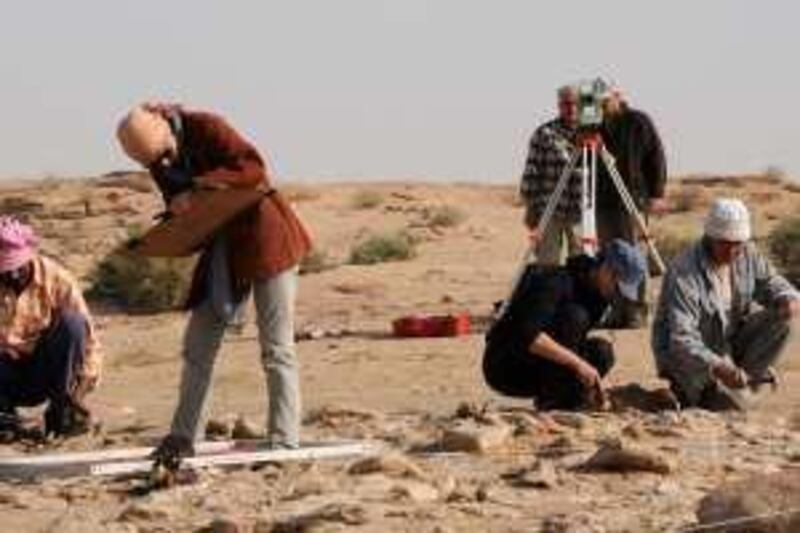With virtually all of Kuwait's population packed into a modern concrete city and a desert dominated by oil wells, it would be easy to think there is little of historical value that would entice archaeologists away from the rich pickings of Egypt, Iran and the Levant. But as a joint Kuwaiti-Polish mission is finding out, the country's shifting sands can hide sites that are so old even the local Bedouin tribesmen forgot they were there. This year, archaeologists are excavating graves and a settlement that could reveal how the Gulf's inhabitants lived 7,000 years ago, along with a well that might have been built by the Ottomans.
The expedition will be one of the last chances for the Polish team to explore the area to the north of Kuwait City known as Subiya. Thirteen Poles arrived last month from the Polish Centre of Mediterranean Research at Warsaw University. The centre has sent teams to the region for three consecutive years, but in 2012 construction crews are scheduled to start laying the foundations for a megaproject known as the City of Silk which is expected to cost US$77 billion (Dh283bn).
The centre sends out 24 expeditions every year, and this year they are in Egypt, Sudan, Lebanon, Syria and Iran. Because it is a "rescue operation", the Kuwaitis are providing the funds. Piotr Bielinski, the director of the research institute who is heading the excavations, said the Poles were on an "intellectual mission", but because Kuwaitis use archaeology to build a national identity, there is also a political angle.
Mr Bielinski said archaeology in Kuwait was given a boost in 1991 after the allied forces ended the Iraqi occupation. Iraq had claimed Kuwaiti territory as its 19th province. He said the Kuwaitis started to legitimise their statehood by "looking for particular features of their civilisation". Danes were the first European archaeologists to focus on the Gulf, in the 1950s, and they are still on Failaka Island, a Kuwaiti island that was an ancient sea trade hub. Their findings have been good news for Kuwaiti nationalists.
"Failaka has already become an object of national pride because Failaka civilisation is Kuwaiti civilisation," Mr Bielinski said. "Many material remains found on Failaka have nothing to do with Mesopotamia," the region between the Euphrates and Tigris rivers that now makes up most of Iraq, and only "some similarities" with Bahrain. Mr Bielinski said the Gulf's nomadic roots presented unique challenges for archaeologists. "We have to look at this in a special way - through the eyes of the Bedouins. It's a special problem: how to reconstruct an ancient people only by their funerary rights." He said only one in 10 or 20 of the graves have not been robbed.
The Poles in Kuwait have split themselves into four teams. One team will focus on a graveyard and a settlement. Both could be from the Ubaid period, a prehistoric Mesopotamian civilisation dating to the fifth and sixth millennia BC. The archaeologists hope to establish a link between the two sites, which lie just three kilometres apart. A third team is excavating a well that could be several hundred years old, and a fourth is scanning the desert with satellite images and information from previous expeditions to try to identify potential archaeological sites. The mission will finish in early December.
The graves and the well have been partially excavated before, but the settlement was discovered only last year. It is at least 20 metres wide and 70 metres in length. The Poles are starting to scrape away sand to reveal the remains of walls and clay pots in the rocky ground. "This is obviously more than a camping site; it's probably a village. You can see the outlines of some rooms," said one of the archaeologists, Agnieszka Szymczak.
Ms Szymczak said the style of the pots would be crucial in determining the settlement's age. They have already identified painted Ubaid pottery on the site. The ground will reveal more of the ancient culture as they dig deeper. Skeletons of children in pots have been found in similar sites from the same period. The graveyard consists of eight circular tombs made from loose rock, several metres in diameter and half a metre high. Some of the graves have been opened before to reveal hundreds of precious stones and beads.
The four-man Kuwaiti team, headed by Sultan al Darwish of the Kuwait National Museum, is bringing local expertise to the mission. Mr al Darwish has written five books on local archaeology and he discovered all of the sites. "I'm a Bedouin. I was looking around for signs of water and I saw some pottery and lithic stone, and mounds of stones that stood out from the surroundings. I thought something might exist here," he said at the settlement, where he had discovered the earliest graves about 15 years ago.
Last week, Mr Bielinski was focusing on the well, which the Poles excavated last year and which has since been reclaimed by desert sands. He said the sea trade routes between the big Mesopotamian cities in the north and Oman in the south, which passed Failaka and Bahrain, have been well established, but he dreamt of discovering a land route across the Kuwaiti desert. The size and complex structure of the well is giving his theory hope.
"It doesn't look like an investment made by a small tribe, maybe it was erected as a chain of wells on a caravan track - but I have no proof," he said. jcalderwood@thenational.ae





